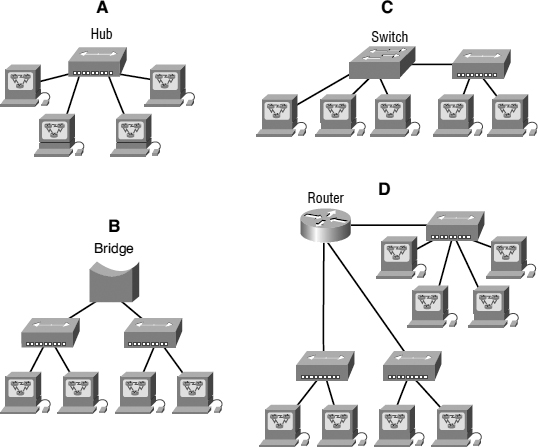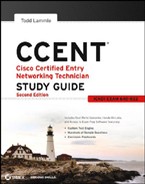Written Lab 1
In this section, you'll complete the following labs to make sure you have the information and concepts contained within them fully dialed in:
- Lab 1.1: OSI Questions
- Lab 1.2: Defining the OSI Layers and Devices
- Lab 1.3: Identifying Collision and Broadcast Domains
- Lab 1.4: Binary/Decimal/Hexadecimal Conversion
(The answers to the written labs can be found in Appendix A.)
Written Lab 1.1: OSI Questions
Answer the following questions about the OSI model:
- Which layer chooses and determines the availability of communicating partners along with the resources necessary to make the connection, coordinates partnering applications, and forms a consensus on procedures for controlling data integrity and error recovery?
- Which layer is responsible for converting data packets from the Data Link layer into electrical signals?
- At which layer is routing implemented, enabling connections and path selection between two end systems?
- Which layer defines how data is formatted, presented, encoded, and converted for use on the network?
- Which layer is responsible for creating, managing, and terminating sessions between applications?
- Which layer ensures the trustworthy transmission of data across a physical link and is primarily concerned with physical addressing, line discipline, network topology, error notification, ordered delivery of frames, and flow control?
- Which layer is used for reliable communication between end nodes over the network and provides mechanisms for establishing, maintaining, and terminating virtual circuits; transport-fault detection and recovery; and controlling the flow of information?
- Which layer provides logical addressing that routers will use for path determination?
- Which layer specifies voltage, wire speed, and pinout cables and moves bits between devices?
- Which layer combines bits into bytes and bytes into frames, uses MAC addressing, and provides error detection?
- A Cisco router has received a frame on an interface that is connected to a local network segment. The router has de-encapsulated the frame. What step is next in processing the packet?
- Which layer is represented by frames?
- Which layer is represented by segments?
- Which layer is represented by packets?
- Which layer is represented by bits?
- Put the following in order of encapsulation:
- Packets
- Frames
- Bits
- Segments
- Which layer segments and reassembles data into a data stream?
- Which layer provides the physical transmission of the data and handles error notification, network topology, and flow control?
- Which layer manages device addressing, tracks the location of devices on the network, and determines the best way to move data?
- What is the bit length and expression form of a MAC address?
Written Lab 1.2: Defining the OSI Layers and Devices
Fill in the blanks with the appropriate layer of the OSI or hub, switch, or router device.
| Description | Device or OSI layer |
| This device sends and receives information about the Network layer. | |
| This layer creates a virtual circuit before transmitting between two end stations. | |
| This layer uses service access points. | |
| This device uses hardware addresses to filter a network. | |
| Ethernet is defined at these layers. | |
| This layer supports flow control and sequencing. | |
| This device can measure the distance to a remote network. | |
| Logical addressing is used at this layer. | |
| Hardware addresses are defined at this layer. | |
| This device creates one big collision domain and one large broadcast domain. | |
| This device creates many smaller collision domains, but the network is still one large broadcast domain. | |
| This device can never run full duplex. | |
| This device breaks up collision domains and broadcast domains. |
Written Lab 1.3: Identifying Collision and Broadcast Domains
Using the information shown in the following illustration, identify the number of collision domains and broadcast domains in each specified device. Each device is represented by a letter:
- Hub
- Bridge
- Switch
- Router

Written Lab 1.4: Binary/Decimal/Hexadecimal Conversion
- Convert from decimal IP address to binary format.
Complete the following table to express 192.168.10.15 in binary format:

Complete the following table to express 172.16.20.55 in binary format:

Complete the following table to express 10.11.12.99 in binary format:

- Convert the following from binary format to decimal IP address:
Complete the following table to express 11001100.00110011.10101010.01010101 in decimal IP address format:

Complete the following table to express 11000110.11010011.00111001.11010001 in decimal IP address format:

Complete the following table to express 10000100.11010010.10111000.10100110 in decimal IP address format:

- Convert the following from binary format to hexadecimal.
Complete the following table to express 11011000.00011011.00111101.01110110 in hexadecimal:

Complete the following table to express 11001010.11110101.10000011.11101011 in hexadecimal:

Complete the following table to express 10000100.11010010.01000011.10110011 in hexadecimal:

